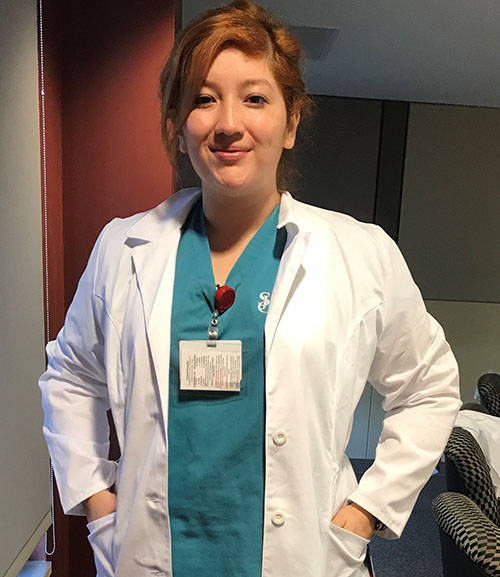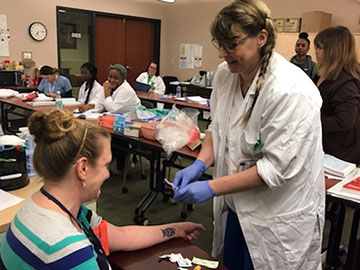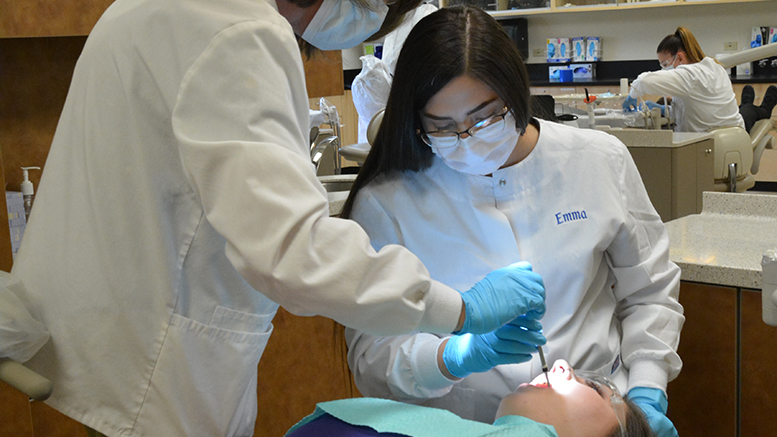Ana Karen Lopez – the oldest of seven children in a family that immigrated from Mexico to Texas – dreamed of becoming a nurse but couldn’t afford a college education without extensive financial assistance.
Thanks to a federal HPOG grant, Lopez was able to quit her dead-end receptionist job and enroll full-time in a licensed vocational nurse program at San Jacinto College without having to spend her own money on textbooks, scrubs or medical supplies. After graduating and passing the National Council Licensure Examination in 2017, she attained a job at Octapharma Plasma, earning $23 an hour and is now working toward an associate degree in nursing.
Lopez is one of thousands of HPOG grantees across the country able to climb out of poverty into a family-sustaining job in healthcare. The program, which stands for Health Profession Opportunity Grants, provides funding to lower-income people, focusing on those receiving benefits from the federal Temporary Assistance for Needy Families (TANF) program.
The HPOG program pays for all college expenses and provides individualized assistance and emergency funding to help recipients overcome barriers that could cause them to drop out. Of the 32 HPOG-funded partnerships in the U.S., 11 are headed by community colleges or tribal colleges.
HPOG is scheduled to expire in September 2020, but community college officials hope it will be extended for at least another year. Meanwhile, the House Ways and Means Committee in October passed legislation – supported by the American Association of Community Colleges – to reauthorize the program for five years and increase annual funding from $85 million to $425 million.
Studying wraparound services
HPOG is part of a national study to measure the impact of wraparound services. Within each HPOG-funded partnership, about two-third of the participants who apply for an HPOG grant are randomly assigned to a control group, and the rest are in a “treatment group,” where they receive more intensive services.

Ana Karen Lopez, a former HPOG grant recipient, completed a vocational nursing program at San Jacinto College. (Photo: SJC)
San Jacinto College (SJC) in Texas has enrolled 1,033 students in its HPOG program in the past four years, and 965 of them have received healthcare training, says Lydia Chavez-Garcia, the former program director who is now a principal investigator.
Lower-income students struggle with basic needs, so the grant provides flexibility to help them overcome those barriers, Chavez-Garcia says. The grant has paid for gas cards, laptops, immunizations and more.
“It’s not just about taking one training course,” Chavez-Garcia says. It’s about getting students onto a health careers pathway. A student can earn a short-term certified nursing assistant (CANA) or phlebotomy credential, work for a while, then come back for more training “to really get out of the poverty cycle,” she says.
Forty-nine HPOG students are working toward degrees as registered nurses, Chavez-Garcia says, and 48 have received a licensed practical or vocational nursing certification and are earning $22 to $23 an hour.
SJC collaborates with employers to pinpoint high-skill, high-growth occupations, along with its vendor partners, workforce board and other colleges that provide healthcare training to HPOG students, such as Alvin Community College, Lee College and College of the Mainland, adds program director DeShawn Pitre.
“Our team goes to those sites a couple of times a month for informational and intake sessions, so those students don’t have to travel to our college,” Chavez-Garcia says. “That’s another way we remove barriers.” The goal is to meet students where they are.
A strong partnership
Rogue Community College (RCC) received a five-year, $14 million HPOG grant as the lead agency in the Southern Oregon Health Occupations Poverty Elimination Project, which also includes Worksource Rogue Valley, the Oregon Department of Human Services and the Rogue Workforce Partnership.
More than 694 unemployed and underemployed people enrolled in the program, says Lisa Parks, administrator of the HPOG grant at the college. Program participants included Supplemental Nutrition Assistance Program (SNAP) recipients and youths aging out of foster care, as well as TANF recipients, she says. Many of them had minimal or no college experience, and a significant number lacked a high school diploma.
Among the students who received HPOG funds, 207 have completed a high school equivalency exam, 641 have entered healthcare training and 250 are working in healthcare in the community, Parks notes. Many of them are still in school, as it takes longer for lower-income students with life barriers to complete a training program. The partnership also used completion specialists to improve participants’ success rates.
All the training programs are one year or less and lead to a certificate in RCC’s career and technical education department. Former HPOG students are working as nursing assistants, medical assistants, community health workers, certified nursing assistants, medical receptionists, medical information clerks, phlebotomists, home health aides, dental assistants, massage therapists, medical insurance coders and emergency medical technician.
About 30 percent of them plan to complete a two-year degree at the community college or pursue a bachelor’s degree.
Through the HPOG grant, RCC provides “hands-on assistance to help students complete their training and address barriers that keep them from being successful,” Parks says. That includes intensive case management; mental health counseling; tutoring; job placement; money for books, supplies and fees; and, if needed, funds for childcare, parking permits and bus passes.
“HPOG supports and rewards people who are looking to improve their quality of life,” Parks says. “And it makes connections with people; it doesn’t just provide services and funds. That’s the part that really matters.”
Collaborating for success
At SUNY Schenectady County Community College in New York, which receives $3 million annually in HPOG funds, 596 student grantees have completed basic skills training, 1,313 have completed health courses and 607 work in healthcare. SUNY Schenectady is the lead agency in the HPOG-funded Upstate Partnership for Healthcare Pathways, which includes two other community colleges – SUNY Adirondack and Fulton-Montgomery Community College (FMCC) – along with the Albany Community Action Partnership and the Schenectady Community Action Program.

An HPOG student prepares to become a phlebotomy technician at Schenectady County Community College. (Photo: SCCC)
Before HPOG, the three colleges didn’t engage much with each other, says project director Tiziana Rota at SUNY Schenectady. The HPOG grant has fostered collaboration, which “has had a ripple impact” and led to broader opportunities for residents within the region.
For example, SUNY Schenectady doesn’t have a radiology technician program, so applicants interested in that profession are referred to FMCC, which does. SUNY Schenectady doesn’t have a nursing school either, but it helped 42 students get training at the regional Board of Cooperative Educational Services, leading to a licensed practical nurse credential.
As the lead agency in the consortium, SUNY Schenectady provides guidance and support to the other partners and helps them develop strategies for recruiting students and sharing best practices, Rota says. HPOG enables low-income people to attain a credential “to get their foot in the door” on the pathway to a professional career, she says.
Most of the HPOG grantees aided by the SUNY Schenectady partnership are female, and their ages range from 18 to 65. The grants help them overcome barriers, such as transportation and childcare, which is a problem for people in nursing, who tend to have nontraditional hours or shift work.
Personalized assistance
Home-based nursing aides need a car, but there’s a catch-22, Rota notes. “The moment they get a full-time job, they lose housing and other benefits,” which she calls the “cliff effect.”
While the college can’t use HPOG funds to purchase a car for grantees, it can assist with gas payments and bus passes.
SUNY Schenectady students awarded HPOG grants receive 60 hours of workforce development or career readiness training before they start their healthcare education. They also get basic training in using computers and developmental education, if needed, while a case manager addresses barriers, such as the need for childcare.
Attendance is a key issue to prepare them for the workforce, Rota says. “Students must understand that they need to show up at 9 a.m., not 9:30,” she says.
The academic training covers the basic skills needed on the job, such as medical terminology and how to convert milliliters to ounces, rather than theoretical math and grammar.
Students in the control group get the same level of academics but do not receive wraparound services or assistance in finding a job. SUNY Schenectady provides members of the control group with referrals to job fairs or alternative social services, such as those available through local agencies or other grants, Rota says.
SUNY Schenectady tries to provide some level of support and continuity for the first 90 days after HPOG grantees complete their training, such as scrubs, clothing for job interviews, assistance in securing a childcare provider or getting their children into Early Head Start. Rota calls is it a “dual-generation approach” that serves parents and their children at the same time.
Preliminary results show “the wraparound support is what makes a difference,” Rota says. Also, she says, the community agency partners provide significant support to help HPOG recipients get jobs, including helping them write resumes and getting interviews.
While the college is in constant touch with employers and adjusts the training program to meet their needs, there have been some obstacles. In one example, some employers thought they could do a better job with in-house training for CNAs. Sometimes they have done well, but in other instances, they cut corners and “had abysmal results,” Rota says.
Some employer-trained CNAs didn’t pass the state exam and came back to the community college for more training. CNA training at SUNY Schenectady takes about 150 hours, because soft skills are a key component, Rosa says. As a result, “Employers tell us when they see HPOG on a resume, they know it’s a solid candidate.”

